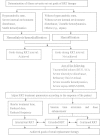New, goal-directed approach to renal replacement therapy improves acute kidney injury treatment after cardiac surgery
- PMID: 24947162
- PMCID: PMC4075594
- DOI: 10.1186/1749-8090-9-103
New, goal-directed approach to renal replacement therapy improves acute kidney injury treatment after cardiac surgery
Abstract
Aim: The aim of this study was to compare the efficacies of goal-directed renal replacement therapy (GDRRT) and daily hemofiltration (DHF) for treating acute kidney injury (AKI) patients after cardiac surgery.
Methods: In our retrospective study, we included 140 cardiac surgery AKI patients who were treated with renal replacement therapy (RRT) from 2002 to 2010. Two patient groups, which comprised 70 patients who received DHF from January 2002 to September 2008 and 70 patients treated with GDRRT from October 2009 to September 2010 were pair-wise compared regarding clinical outcomes, as well as the incidence of adverse events.
Results: In-hospital and 30-day mortality rates were 45.7% and 41.4% in the GDRRT and 48.6% and 54.3% in the DHF group, respectively, but without statistically significant differences. GDRRT patients needed statistically significantly shorter hospital and intensive care unit (ICU) stays, less frequent RRT, and shorter RRT sessions, whereas, of 11 analyzed renal outcome parameters, 6 values, including percentage of complete renal recovery and time for complete renal recovery, were significantly superior in the GDRRT group at the time of discharge. There was no significant difference in the incidence of adverse events within the initial 72 treatment hours between the 2 groups. Hospitalization expenses were less in GDRRT group than in DHF group.
Conclusion: The GDRRT approach is superior to DHF for improving renal outcome, as well as reducing the time and cost of RRT therapy, for cardiac surgery AKI patients.
Similar articles
-
Early goal-directed renal replacement therapy in severe pneumonia associated acute kidney injury.Ren Fail. 2024 Dec;46(2):2392844. doi: 10.1080/0886022X.2024.2392844. Epub 2024 Sep 4. Ren Fail. 2024. PMID: 39229916 Free PMC article.
-
[Goal-directed renal replacement therapy for acute kidney injury after cardiac surgery].Zhongguo Wei Zhong Bing Ji Jiu Yi Xue. 2011 Dec;23(12):749-54. Zhongguo Wei Zhong Bing Ji Jiu Yi Xue. 2011. PMID: 22153014 Chinese.
-
Efficacy of Early Goal-Directed Renal Replacement Therapy for the Treatment of Acute Kidney Injury After Heart Transplantation: A Single-Center 10-Year Experience.J Cardiothorac Vasc Anesth. 2020 Jun;34(6):1534-1541. doi: 10.1053/j.jvca.2019.11.022. Epub 2019 Nov 21. J Cardiothorac Vasc Anesth. 2020. PMID: 31879149
-
Effect of acute kidney injury care bundle on kidney outcomes in cardiac patients receiving critical care: a systematic review and meta-analysis.BMC Nephrol. 2025 Jan 10;26(1):17. doi: 10.1186/s12882-025-03955-1. BMC Nephrol. 2025. PMID: 39794703 Free PMC article.
-
Timing of renal replacement therapy initiation for acute kidney injury in critically ill patients: a systematic review of randomized clinical trials with meta-analysis and trial sequential analysis.Crit Care. 2021 Jan 6;25(1):15. doi: 10.1186/s13054-020-03451-y. Crit Care. 2021. PMID: 33407756 Free PMC article.
Cited by
-
Evaluation of five different renal recovery definitions for estimation of long-term outcomes of cardiac surgery associated acute kidney injury.BMC Nephrol. 2019 Nov 21;20(1):427. doi: 10.1186/s12882-019-1613-6. BMC Nephrol. 2019. PMID: 31752748 Free PMC article.
-
Impact of dialysis practice patterns on outcomes in acute kidney injury in Intensive Care Unit.Indian J Crit Care Med. 2016 Mar;20(3):198. doi: 10.4103/0972-5229.178189. Indian J Crit Care Med. 2016. PMID: 27076737 Free PMC article. No abstract available.
-
Early goal-directed renal replacement therapy in severe pneumonia associated acute kidney injury.Ren Fail. 2024 Dec;46(2):2392844. doi: 10.1080/0886022X.2024.2392844. Epub 2024 Sep 4. Ren Fail. 2024. PMID: 39229916 Free PMC article.
-
Role of Body Mass Index in Acute Kidney Injury Patients after Cardiac Surgery.Cardiorenal Med. 2017 Dec;8(1):9-17. doi: 10.1159/000477824. Epub 2017 Sep 16. Cardiorenal Med. 2017. PMID: 29344022 Free PMC article.
References
-
- Haase M, Shaw A. Acute kidney injury and cardiopulmonary bypass: special situation or same old problem? Contrib Nephrol. 2010;9:33–38. - PubMed
Publication types
MeSH terms
LinkOut - more resources
Full Text Sources
Other Literature Sources
Medical


